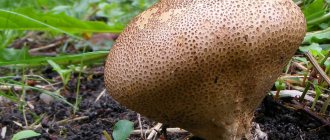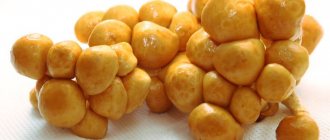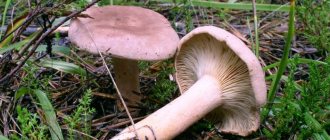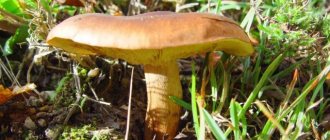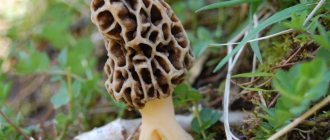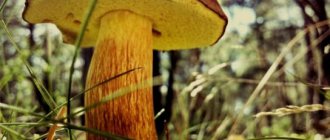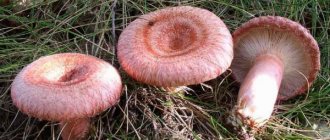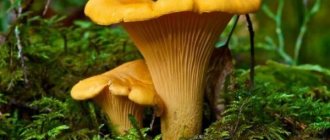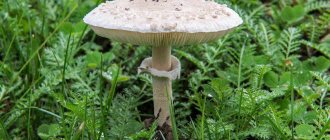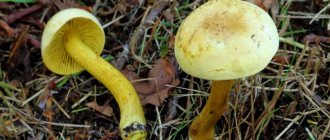Rhizopogon vulgaris is an edible mushroom that belongs to the 4th taste category. This little-studied mushroom can be a big disappointment for mushroom pickers. The fact is that it is quite similar in appearance to the noble and rare (and very expensive) truffle mushroom.
Rhizopogon is edible, but it is not a delicacy like its highly valued counterpart; its taste is rather reminiscent of puffballs. The discovery of rhizopogon is a rare occurrence, since, like a truffle, its fruiting body is almost completely hidden in the soil. Apparently, for the same reason, there is rather little information about it in the mycological literature.
Where do pinkish rhizopogons grow?
The rhizopogon mushroom is found under spruce and pine, in mixed forests where oak predominates, and is less common under other deciduous trees. It is located in groups shallow in the soil, covered with leaf or coniferous litter. Only a small portion of ripe specimens appear on the surface, and even then rarely. The growth pattern makes it difficult to harvest and determine the boundaries of the population.
Fruiting is long, harvesting begins in mid-summer. In the middle zone, if the autumn is warm with sufficient rainfall, the last specimens are found in mid-October. The main accumulation of blushing truffle is sought near pine and spruce trees under a coniferous cushion.
Ecology
A sporocarp of Rhizopogon roseolus
in cross section showing a close up of the gleba locules
Mammalian diet and spore dispersal
Rhizopogon
species have been established as a common component in the diet of many small mammals as well as food in Western North America.
The viability of Rhizopogon
spores is maintained and may even be increased after mammalian gut passage, making mammals an important dispersal vector for
Rhizopogon
.
Disturbance ecology
Rhizopogon
species are common members of the fungal communities that colonize the roots of trees during seedling establishment and persist into old growth stands.
Rhizopogon
spores are long lived in soil and the spores of some species can persist for at least four years with an increase in viability over time.
Rhizopogon
seems to be especially common upon the roots of establishing tree seedlings following disturbance such as fire or logging.
Rhizopogon
are also abundant colonizers of pot cultivated and field cultivated conifer seedlings growing in soil from conifer stands that lacked observations of
Rhizopogon
upon the roots of mature trees.
These findings suggest that Rhizopogon
species are an important factor in the recovery of conifer forests following disturbance.
Invasive facilitator
Rhizopogon
species have been shown to have a global distribution in the Homogenocene.
The enzymes exuded from some species within the subgenus amylopogon is essential in activating seed germination in some species of Monotropoideae, such as Pterspora andromedeae
.
This makes Rhizopogon an obligatory host to species like P. andromedeae.
The exoenzymatic activity also confers higher competitive advantages to the host species, mainly within the genus
Pinus,
by helping to break down nutrients within the soil.
The presence of Rhizopogon in soil facilitates Pinus
as an invasive species.
This exoenzymatic activity is nitrogen limited. In the case of R. amylopogon
parasitized by
P. andromedeae
the nitrogen cost of exoenzymatic production is in part paid for by bacteria within the family Burkholderiaceae that is hosted by
P. andromedeae
Species
- Rhizopogon albidus
- Rhizopogon ater
- Rhizopogon amylopogon
- Rhizopogon atrovilaceus
- Rhizopogon brunneniger
- Rhizopogon ellenae
- Rhizopogon evadens
- Rhizopogon fulvigleba
- Rhizopogon fuscorubens
- Rhizopogon hawkerae
- Rhizopogon luteolus
- Rhizopogon nigrescens
- Rhizopogon occidentalis
- Rhizopogon ochraceorubens
- Rhizopogon parksii
- Rhizopogon parvisporus
- Rhizopogon pedicellus
- Rhizopogon roseolus
- Rhizopogon salebrosus
- Rhizopogon subareolatus
- Rhizopogon subaustralis
- Rhizopogon subcaerulescens
- Rhizopogon subpurpurascens
- Rhizopogon subsalmonius
- Rhizopogon succosus
- Rhizopogon togasawariana
- Rhizopogon truncatus
- Rhizopogon vesiculosus
- Rhizopogon villosulus
- Rhizopogon vinicolor
- Rhizopogon vulgaris
What do pinkish rhizopogons look like?
Rhizopogons are not divided into a stem and a cap. The fruit body is uneven, round or tuberous in shape. They grow under the top layer of soil; most often there are only long threads of mycelium on the surface.
Description of the species:
- The diameter of the fruiting body of an adult specimen is 5-6 cm.
- The peridium is first whitish, then yellow with a greenish tint.
- When pressed, the place turns red, and the color also changes after removal from the soil, the peridium oxidizes and turns pink, hence the species name.
- The surface of young specimens is rough and velvety. Ripe mushrooms become smooth.
- The pulp is dense, oily, during ripening it changes color from white to light brown, turning red at the cut site. The inner part of the peridium consists of numerous longitudinal chambers filled with spores.
Advice! In the lower part of the pinkish rhizopogon, thin white rhizoforms are clearly visible, which can be used to trace where the colony is located.
Description
Rhizopogon vulgare.
The fruiting body of Rhizopogon is shaped like a raw potato, tuberous or irregular in shape. It reaches approximately 5 centimeters in diameter.
The skin of a young mushroom is velvety to the touch; as the fruiting body matures, it becomes smooth, cracked in places. The color of the mushroom in youth is gray with a brown tint; in aging mushrooms it becomes olive-brown.
The pulp of the common rhizopogon is dense, light, and as it grows and ripens, it darkens, acquiring a yellow, sometimes olive-green, color. In the thickness of the pulp there are small narrow cavities in which the spore powder matures.
The spores are ellipsoidal, oily, yellowish in color. The pulp is without pronounced taste and smell. In the lower part of the fruiting body there are mycelium threads that look like dense white threads.
Similar species
First of all, the pinkish rhizopogon is very similar to its own “brother” - the common rhizopogon (yellowish) . The differences between them are only in the color of the pulp (in the ordinary species it does not turn red and is brown or yellow). In terms of nutritional qualities, both mushrooms are identical.
Sometimes the pink rhizopogon is also called the “fool's truffle” because of its external similarity to a delicious truffle, for example, the African truffle . Eating truffles in Russia is rather exotic, and therefore many people have a rather rough idea of what this expensive mushroom actually looks like. This is what scammers often take advantage of, passing off a rather mediocre mushroom as an expensive delicacy and profiting handsomely from it.
1- Common rhizopogon 2- African truffle
Rhizopogon roseata has no poisonous analogues.
References
- Fries, Elias Magnus (1817). Symbolae Gasteromycorum
. Lundae: Ex officina Berlingiana. - Martin, M. P. (1996). The Genus Rhizopogon in Europe
. Barcelona, Spain: BCG. pp. 173 p. ISBN. - Maser C, Maser Z (1988). "Interactions among squirrels, mycorrhizal fungi, and coniferous forests in Oregon." Western North American Naturalist
.
48
(3):358–369. - Izzo AD, Meyer M, Trappe JM, North M, Bruns TD (2005). "Hypogeous ectomycorrhizal fungal species on roots and in small mammal diet in a mixed conifer forest." Forest Science
.
51
(3):243–254. - Gans, Maya (2019). "Invariant Communities of Endophytic Nitrogen-fixing Bacteria Associated with a Non-photosynthetic Plant". ProQuest Dissertations Publishing
. - Kessel S. L. (1927). "Soil organisms. The dependence of certain pine species on a biological soil factor". Empire Forestry Journal
.
6
: 70–74. - Steinfield D, Amaranthus M, Cazares E (2003). "Survival of Ponderosa pine ( Pinus ponderosa
Dougl. ex Laws) seedlings outplanted with
Rhizopogon
mycorrhizae inoculated with spores at the nursery."
Journal of Arboriculture
.
29
(4):4197–208. - Trappe, M; Evans; Trappe, J (2007). Field guide to North American Truffles
. Berkeley, CA: Ten Speed Press. pp. 136 p. ISBN 978-1580088626.
Distribution and collection
Common rhizopogon grows from June to October. Its pleasant property for mushroom pickers is that rhizopogon almost never grows in single specimens, so that, having found one mushroom, you can confidently expect that several more are lurking nearby.
You can meet the common rhizopogon in pine and spruce forests, less often in mixed ones; it prefers to settle near coniferous trees. As a rule, the fruiting body is completely or almost completely hidden in the soil, but “surface” specimens are found, albeit much less frequently.
White truffle
mushroom wind
In addition to producing an insane amount of yeast, mushrooms can cause wind.
In a way, a mushroom is like a fruit hanging on a tree. The mushroom cap is full of spores, like a fruit is full of seeds. However, unlike a tree, most of the fungus is hidden underground. The mycelium forms a network connecting the mushrooms on the surface.
Image copyright Thinkstock Image caption Molds are also fungi
Mushrooms need their spores to fly as far as possible; then the offspring will not compete with their “parents” for nutritional resources. At the same time, mushrooms cannot count on the help of animals when traveling long distances. They have to rely on themselves and use available resources. The main one is water.
When it's time to spray their spores, the mushrooms release water vapor, thereby cooling the air around them. Air currents create a lifting force that can carry spores up to 10 centimeters in all directions.
False doubles
The most similar lookalike is the common rhizopogon (Rhizopogon vulgaris).
Externally, the fruiting bodies of the double resemble potato tubers in color and shape. The surface of the peridium is velvety and light olive in color. The pulp is creamy, dense and oily when cut, darkens slightly, and does not turn reddish. The method, time and place of growth are the same among species. A similar mushroom belongs to the fourth group in terms of nutritional value.
Ethnomycology
Forestry
The first intentional use of Rhizopogon
species in forestry occurred in the early part of the 20th century when
Rhizopogon luteolus
was deliberately introduced into
Pinus radiata
plantations in Western Australia after it was observed to improve tree growth.
Since that time, Rhizopogon
species have been widely studied as a component of managed forests.
Rhizopogon
species have been noted as common members of the ectomycorrhizal community colonizing tree roots of pine and Douglas-fir timber plantations.
Naturally occurring Rhizopogon roseolus
(
=rubescens
) spores have been shown to out-compete the spores of other ectomycorrhizal fungi in pine plantations even when competing spores were directly inoculated onto seedlings.
The survival rate and performance of pine and Douglas-fir plantation seedlings are increased after inoculation with Rhizopogon
species.
Gastronomy
Though many species of Rhizopogon
are considered edible, most are not held in high culinary esteem.
A notable exception is Rhizopogon roseolus
(
=rubescens
) which is considered a delicacy in east Asia and especially in Japan where it is traditionally known as Shoro. Techniques for the commercial cultivation of this fungus in pine plantations have been developed and applied with successful results in Japan and New Zealand.
Yellow egg capsule
Similar articles
Aponogeton
Marsh-leaved herb
Biological systematics of the main taxonomic ranks of the yellow water lily (Russian and Latin names):
| Kingdom (Regnum) | Plants (Plantae) |
| Type (Phylum) (division) | Flowering plants (Angiospermae) |
| Class (Сlassis) | Dicotyledons (Magnoliopsida) |
| Squad (Ordo) (order) | Nymphaeales |
| Family _ | Nymphaeaceae |
| Genus _ | Capsule (Nuphar) |
| Species _ | Yellow egg capsule (Nuphar lutea) |
Botanical description
Rhizome
The rhizome is horizontal, thick and long, creeping, covered with rounded-triangular scars from leaf fall. The surface is dark gray, at the fracture it is grayish-cream or yellow. The roots are numerous, extending their system under water into the silt.
Leaves
The yellow capsule belongs to the group of plants called hydadophytes. Such plants are fully or half immersed in water. The lower leaves are semi-transparent and submerged, with fibrous edges. The upper ones are floating above the water, long-petiolate, leathery, oval or ovoid in shape, with a deeply heart-shaped base, entire edges.
Flower
The flowers are large, solitary, bisexual. Sepals and petals are collected in a ring. The first ones are yellow on the outside and green on the inside. The petals are obversely heart-shaped, 30% smaller than the calyx. They are odorous, protrude 5-6 centimeters out of the water, and have an alcoholic smell to attract insects. The anthers are oblong-linear, the ovary is oval-conical. The plant begins to bloom in late spring and continues to bloom until the end of summer, sometimes early autumn.
The fruit is berry-shaped, green, juicy, 4-5 mm long. Fruit ripening occurs on the surface of the water in late summer or early autumn. There is an air sac around the seeds, so they have the ability to spread over long distances.
Reproduction
Yellow egg pods reproduce using seeds. Each yellow egg capsule flower contains a so-called “honey pit” that attracts pollinators. With the help of water, seeds covered with mucus are carried over long distances. They are also spread by fish that eat them and birds, thanks to sticky fruits sticking to their paws.
Varieties of yellow egg pod
Photo of yellow egg pod
There are eight varieties of the plant, including three hybrid forms. However, scientists have not yet come to a consensus regarding species and subspecies. Some biologists argue that the five varieties of yellow egg capsule should be positioned as independent species, while another part says that these are just its subspecies. The main ones are: Japanese, small, white, Kalmiana, foreign, multi-petalled, small-petalled.
White egg capsule
Photo of white egg pod
Nymphaea alba - like the yellow egg capsule - is an aquatic perennial herbaceous plant. It has a large root and numerous branched rhizomes that float on the water. The leaves are large, round in shape, with a heart-shaped notch. The flower is large with white petals. A special feature is the large number of petals and the fact that the inner ones are much smaller than the outer ones. The green fruit of the plant is round in shape and ripens under water. The white egg capsule can be found in Ukraine, Russia, and Belarus.
White egg capsules on the water
In medical and pharmaceutical practice, white egg capsule is valued due to its content of alkaloids (nymphair), tannins, and starch. Used for diseases of the genitourinary tract.
Small egg capsule
Photo of a small egg pod
Nuphar pumila is an aquatic perennial plant with a thick rhizome. It has large heart-ovate leaves with veins. The flowers are single with yellow petals (4-6 pieces per flower). The green fruit has a berry-like shape. The small egg capsule can be found in Europe, Russia, China, and Japan.
In medical and pharmaceutical practice, the rhizomes of the small egg capsule are used, the main active ingredient of which is the alkaloid nufaropumyline.
Beautiful photo of a small egg pod
Preparations with the plant are used to lower blood pressure and achieve an antispasmodic effect.
Some species of water lilies are on the verge of extinction and are listed in the Red Books of countries around the world. These include:
– white (Russia, Ukraine)
– small (Russia, Belarus).
Spreading
The plant grows on lakes, ponds, and river banks. The yellow egg capsule grows in flowing waters; it prefers places where there is no current. The general area of existence is Asia and Europe. The yellow egg capsule is listed in the Red Books of the countries of the world (Russia, Belarus, Ukraine). The plant is endangered, as the ecological situation is deteriorating, water bodies become polluted and tend to dry out.
Story
Small yellow egg capsule on the water
The yellow capsule is one of the oldest flowers on our planet. The plant appeared on Earth 30 million years ago. The water lily has retained a number of features characteristic of the first angiosperms: the presence of variations in the number of stamens and pistils (other families are characterized by a certain number), the absence of a clearly defined boundary between the stamen and the petal. In Western fairy tales, it is said that each water lily has its own elf. This creature is born and dies with the plant. An ancient Greek story says that a nymph died from an unsuccessful love for Hercules and became a beautiful flower. The first description of the plant was made by the English botanist D.E. Smith. in the 19th century.
Use in medicine
Chemical composition
Yellow egg pods covered the lake
Egg capsule alkaloids have a unique structure and, in addition to nitrogen, contain heteroatoms of sulfur and oxygen (furan ring). These alkaloids are known as nufaridines and thiobinufaridines. Previously, they were classified as quinolizidine alkaloids, but biogenetically they are of isoprenoid origin.
In the total alkaloids, α and β-nufaridines (0.4-0.5%), nuphalein, pseudothiobinufaridine, deoxynufarides, and the like were found. The rhizomes of the yellow water lily also contain tannins, sitosterol, stigmasterol, carotene, starch (20%).
Procurement of raw materials
Raw materials from the egg capsule
In medical and pharmaceutical practice, the rhizomes of yellow capsule are used. They are harvested in the fall. The rhizomes are first trimmed with a knife, and then pulled out of the water with a pitchfork, rake or hands. Leaves, roots, rotten parts are separated. Next, the rhizomes are washed, cut into pieces, and laid out in a thin layer. The next step is to wither in the sun and dry under a canopy or in dryers at a temperature of 60°C. Yellow water lily is a plant with a limited distribution and small reserves of raw materials. Procurement of rhizomes is licensed. To restore growth, 15-20% of the plants are left untouched.
Biological action
The yellow capsule tilted its flower
Alkaloids from the plant's rhizomes exhibit protistocidal and protitostatic effects. Lutenurine (a mixture of alkaloid hydrochloride) acts externally as a contraceptive. Such drugs are classified as chemical contraceptives; they have spermicidal activity. The medicine is released in the form of vaginal balls and inserted into the vagina 10-15 minutes before sexual intercourse. The use of a drug with lutenurin occurs under the supervision of a physician.
Preparations based on rhizomes also treat trichomonas and urogenital infections.
Medicines containing the plant have antimicrobial, antifungal effects and are resistant to antibiotics. They are also characterized by bile and diuretic, antispasmodic, analgesic activities. Medicines with the plant are taken for uterine bleeding as a hemostatic, for decreased male function, nocturnal emissions (which are accompanied by pain), peptic ulcers and gastritis.
A well-known drug for yellow capsule is Lutenurin. The drug is available in the form of liniment, suppositories and foaming tablets. The drug has antimicrobial activity, a wide spectrum of action, suppression of the growth of gram-positive microbes, fungi of the genus Candida, and spermaticidal activity. Lutenurin is recommended for people with trichomonas infections, as well as infections caused by fungi of the genus Candida.
Photo of a lonely egg pod
To treat trichomonas diseases, liniment is used intravaginally every day. Additionally, suppositories are used. The drug is used in three courses, each lasting 10-20 days. Suppositories and foaming tablets are recommended as a means of contraception. They are used according to the instructions 10-15 minutes before the start of sexual intercourse.
When using the drug, irritation and redness of the vagina are possible. If these symptoms occur, you should consult a doctor.
In homeopathy, fresh rhizomes of yellow capsule are used for sexual weakness, enterocolitis, itching and psoriasis.
Side effects
Dragonfly sits on an egg pod
Important to know and remember! Yellow capsule is not a safe plant to use. It is poisonous! It is not recommended to use it for medical purposes on its own. The water lily is used according to the doctor’s prescription and under his supervision, in the quantities prescribed in the prescription and for the duration of the course. In case of poisoning, gastrointestinal disorders occur (indigestion, vomiting).
Use in folk medicine
Traditional medicine has long known the yellow capsule due to its beneficial medicinal properties. Let's look at recipes and actions when using the plant.
– To treat headaches, the leaves of the yellow capsule are used. It is believed that the effect of using the plant occurs after its leaves dry.
– infusions and decoctions of yellow egg capsule are used to reduce temperature.
– an infusion of flowers is used as a tonic and sedative. To prepare, take: boiling water and flowers in a ratio of 50:1 (it is better to prepare for 1 liter), leave for 60 minutes, filter. Take an infusion of 15 ml (1 tbsp) two to three times a day.
– a decoction of rhizomes is used for urolithiasis. To prepare, take: boiling water and rhizomes in a ratio of 20:1 (it is better to cook for 100-200 ml), boil for 20 minutes, leave for 90-120 minutes, filter. The decoction is drunk 20-25 drops two to three times a day.
– a decoction of flowers is used for tonic baths and washes. To prepare, take: boiling water and rhizomes in a ratio of 25:1 (it is better to prepare for 1 liter), boil for 10-15 minutes, leave for 30 minutes.
– for bruises, a compress is recommended. To prepare, take: 50 g of flowers, wrap in a piece of gauze and place in hot water for 5 minutes. Apply a compress to the injury site.
Yellow egg capsule in other industries
Use on the farm
Important! The rhizomes of the yellow capsule are poisonous, so they are not consumed raw. The plant is eaten after boiling in salt water. Thanks to this, the plant loses its properties that are dangerous to humans and its bitter taste, and becomes acceptable for food.
The rhizomes of the plant are prepared in two ways, depending on preference:
Fried
The rhizomes of the capsule are cleaned, washed with cold water, and boiled in salt water for 40 minutes. Next, fry in butter for 20 minutes and eat warm.
Boiled
The rhizomes are cleaned, washed with cold water, and boiled in salt water for 40 minutes. Serve hot or warm with butter.
Porridge from rhizomes
The rhizomes are cleaned, washed with cold water, passed through a meat grinder to grind, and filled with water for 5 hours. These steps are repeated three more times. Next, the water is drained and boiled with spices and salt in water for one hour.
Egg pod on the water
Also, crushed rhizomes are added to rye flour and baked into flat cakes, bread, pies, and buns. To obtain flour, you should: dry the rhizomes, grind them into powder, add water at the rate of half a bucket of water per kilogram of flour and leave for two to three hours. The steps are repeated 2 more times, then the resulting flour is spread out in a thin layer and dried.
Animals such as muskrat, beaver, and nutria feed on the yellow egg capsule, which confirms its role in the animal world.
Roasted yellow capsule seeds are used to make a drink that resembles the taste of coffee.
Application in cosmetology
– To strengthen hair, a decoction of rhizomes is recommended. To do this, use beer and rhizomes in a ratio of 25:1. Add the plant to the beer and boil for 10 minutes, filter. Apply 4-6 times a month. Treatment lasts two months
– to give hair strength and lightness, use a decoction of flowers. To do this, pour boiling water over the flowers in a ratio of 25:1 (it is better to prepare for 1 liter), boil for 10 minutes, leave for 30 minutes. Use the decoction as a rinse after washing your hair with shampoo.
– for skin rashes, use a decoction that is added to the water when taking a bath. To prepare, pour 500 ml of boiling water into 2 tablespoons of egg capsule flowers and boil for 20 minutes. Leave in a dark place for 5 hours, filter. The resulting decoction is added to warm water when taking a bath.
Data
The flowering of the egg pod depends on the place where it grows. For the southern regions, flowering is typical in May, for the northern regions - in June. The flower closes in the morning and evening, plunging into the water. In case of strong wind or rain, the flower also hides.
For the Slavic peoples, the yellow capsule symbolized fidelity and separation. There was a legend: when a person approaches a lake, pond or river without a talisman and picks a yellow egg capsule, he dooms himself to death. The reason for this is the mermaids, who protect the pond and will certainly pull a person to the bottom. Even if he manages to get out of the mermaid’s hands, his life will be doomed to suffering and failure. It was also unacceptable to purchase a flower, since it was believed that with it the sorrows and hardships of the seller of the plant were indulged.
Photo of a beautiful lonely egg pod
For the Italian peoples, the flower is a symbol of deception. This is connected with the story about the Italian Melinda. One day a girl and her friends were walking along the shore of a swampy lake. During the walk, the Italian woman was fascinated by the yellow flowers that grew on the surface of the water. Without thinking for a minute, the girl decided to take one flower with her. Melinda came closer and stepped on the first stump in the water for support. Instantly the stump sank along with the Italian. A swamp monster was hiding in the shape of a stump, which took the girl forever to its kingdom.
The harm of talkers
Before using the talker, get tested for an allergic reaction to the mushroom.
The list of beneficial properties is impressive, but the talker is harmful if consumed in excess. If there are a lot of mushrooms in the diet, a person feels unwell, and pathogenic microflora actively multiplies in the gastrointestinal tract.
- Exacerbates diseases of the gastrointestinal tract. After excessive gas formation, stool is disrupted, the mucous membrane suffers and swells, the person feels nauseous, vomits, becomes dizzy, even leading to an acute migraine.
- Increases the tone of the mucous membrane of the bladder. Frequent urges impair night rest and wash away phosphorus and calcium.
Absolute contraindications:
- The fungus exacerbates painful and uncontrollable muscle contractions in epilepsy.
- Increases heart rate.
- If you have gastritis and ulcers, you should not eat talkers. Fungi affect the mucous membrane, but it is already expressed.
- Increases blood pressure.
- Disturbs the menstrual cycle.
- Poisoning by talkers, what a person feels:
- Mushrooms, like a sponge, absorb toxins and harmful substances from the environment that affect the body, even if a person has not consumed poisonous specimens.
- The face turns red, sweating increases, bronchospasm is observed, breathing becomes difficult, salivation and temperature increase, the body trembles, and oxygen in the blood decreases.
- When consuming poisonous mushrooms, the activity of the cardiovascular system worsens, the walls of blood vessels weaken, they become clogged with plaques and blood clots, and blood circulates with difficulty.
- A person's vision is impaired and he sees poorly. Hallucinations, loss of orientation, laughter, aggression occur, alternating with apathy. The body trembles, it shudders, the bronchi wheeze.
If a person has eaten few mushrooms, the symptoms subside after 2-3 hours. If the portion was large, suffocation occurs due to breathing problems.
External links [edit]
| Wikimedia Commons has media related to Rhizopogon . |
- Fungus index
- A preliminary account of North American species of Rhizopogon
by Alexander H. Smith and S.M. Zeller, 1966 (Full text of the monograph).
| Taxon identifiers |
|
Use
For consumption, it is necessary to choose young specimens with flesh of a pleasant creamy color (old dark mushrooms cannot be used).
They must first be washed under running water, thoroughly scrubbing each specimen to remove the garlic taste and smell, then peel the thin skin.
Rhizopogon luteolus is prepared in the same way as puffballs, which are their closest relatives. All types of culinary processing are suitable for cooking - boiling, frying, stewing, baking, but they taste best when fried.
Attention! The mushroom can be dried, but only at high temperatures, otherwise it will germinate
Mushrooms are faster than bullets
When it comes to the speed of releasing offspring from the house, mushrooms have no equal among living organisms.
Spores of the dung fungus Pilobolus crystallinus fly faster than bullets and any living organisms on our planet.
In appearance, Pilobolus does not look like an ordinary mushroom. It resembles a tiny transparent snake with a bowler hat on its head. This cap is a bag of spores, and the mushroom can shoot it off, and the maximum speed of movement of the bag of spores can reach 25 meters per second, and the acceleration is 1.7 million meters per second squared. For comparison, the American Saturn 5 rocket, which was used to launch the second lunar mission, Apollo 8, accelerated no faster than 40 meters per second squared.
Image copyright Jason Hollinger CC by 2.0 Image caption This mushroom has 28,000 gender variations
It is not surprising that in the English-speaking world this mushroom is called "hat-drop".
If you want to compare this dung cannon to a firearm, here's a great Earth Unplugged story.
Spoiler: yes, Pilobolus spores fly faster than bullets and pellets.
Why are flywheels useful?
When talking about the beneficial properties of mushrooms, the first thing that comes to mind is their rich protein content. Moss fly, like its relatives, is also generous with proteins, the chemical composition of which is very similar to meat. This protein product is useful for restoring physical strength during periods of intense growth and muscle mass building. Protein is necessary for people engaged in mental activity, as well as for the strengthening and regeneration of almost all tissues in the body. In addition, the proteins contained in the product are a set of essential amino acids for humans, without which healthy activity is impossible. By the way, some sources claim that flywheel is the leader in amino acid content among other mushrooms.
The second advantage of this delicacy is its rich vitamin composition. Moss mushrooms are a storehouse of vitamins A, C, D, as well as many vitamins from group B. You can almost completely restore the daily requirement of copper and zinc from one serving of these mushrooms. In addition, they are rich in molybdenum, calcium and chitin. The unique characteristics of moss mushroom include special essential oils and enzymes contained in the caps. The speed of food digestion depends on these substances. This means that flywheel improves the functioning of the digestive system and the quality of absorption of nutrients from food.
It also has natural antibiotic properties, strengthens the immune system and is useful for increasing hemoglobin. In folk medicine it is known as a product with diuretic, tonic and anti-inflammatory properties. It was used for rapid healing of wounds, as a natural antiseptic. And thanks to the presence of molybdenum, it is useful for treating the thyroid gland. The rich vitamin composition of moss mushrooms is the key to good vision, healthy hair and beautiful skin. The ability to speed up metabolism has given flywheel its fame as an anti-obesity mushroom. The unique chemical composition of moss mushrooms makes them beneficial for the nervous system, brain function, kidneys, as well as for the rapid restoration of bone and muscle tissue.
Use in cooking
Common milkweed is usually pickled. When salted, smoothie has a pleasant sour taste, which sets it apart from other mushrooms. After salting, the color changes - it becomes bright yellow.
Typically, preparation is carried out according to three recipes:
- pickling;
- hot salting;
- cold salting.
Before proceeding to the pickling procedure, it is necessary to carry out primary processing of the milkweed.
The mushroom is cleaned of contaminants, rot and damage are removed. Then you should soak the smoothie. The process continues for a day, and the water is changed more than once (about 6 times). After this procedure, the common milkweed can be processed further.
To marinate mushrooms weighing 2 kg you will need about a liter of water and 20 g of salt. For the marinade you need: 120 ml vinegar, 2 tsp. salt, 1 tsp. sugar and spices. It’s a good idea to use 2 bay leaves as spices, 2 pcs. cloves and 3 peas of allspice.
Preparation includes the following processes:
- Boil the mushrooms with salt for about 40 minutes.
- Milk plants should be washed under cold running water.
- Make a marinade (add vinegar, salt, spices, sugar to new water and boil), add milkweed at the end. Cook the mixture for 15 minutes.
- Place the finished mushrooms in a clean container, pour plenty of marinade over them and place in the refrigerator.
If you want to add a more piquant taste to the smoothie, then the second cooking method is suitable for you - hot. Salting with this method requires more components than with conventional pickling.
You will need: 500 ml of water, 2 tbsp. l. salt, 6 cloves of garlic, 2 bay leaves, 3 dill umbrellas, 3 currant leaves, 5 allspice peas, 6 tbsp. l. olive or sunflower oil, salt (added to taste).
The hot salting procedure consists of:
- From boiling milkweed in salted water with bay and pepper.
- Separate the marinade from the smoothies and put them in jars with the addition of garlic, dill and currant leaves.
- Pour the brine into the container with the mushrooms so that the liquid completely covers them.
- Adding vegetable oil and sealing with lids.
After the completed processes, it is recommended to store the milkweed in a dark, dry place at a temperature not exceeding +25°C.
And finally, the third way to prepare smoothies is cold salting. This simple method allows you to process 1 kg of mushrooms using 3 tbsp. l. salt, 3 bay leaves, 3 pcs. horseradish, 3 cloves of garlic, 3 buds of cloves, 6 peas of allspice.
Procedure algorithm:
- Place the mushrooms in a saucepan with a thin layer of salt on the bottom. The hats of the smoothies are directed downwards.
- Spices are added to the mushrooms (laurel, horseradish, cloves, pepper, chopped garlic).
- Then they put salt again, then again the milkweed, spices, and so on until the smoothies run out.
- They put pressure on the smoothies and cover them with a cloth, leaving them in a dark place for a month. After this time, the dish can be tasted.
Taxonomy and diversity
A sporocarp of Rhizopogon luteolus
(
=obtextus
) showing rhizomorphs with adhering substrate
Historical classification
The genus Rhizopogon
occurs throughout the natural and introduced ranges of family Pinaceae trees.
Though this range covers much of the northern temperate zones, the diversity of Rhizopogon
species is well characterized only in North America and Europe.
There are currently over 150 recognized species of Rhizopogon
.
The morphology of Rhizopogon
species is highly cryptic and characters vary greatly throughout sporocarp maturity. This has led to the description of multiple species from various developmental stages of a single fungus.
The genus Rhizopogon
was first described from Europe by Elias Magnus Fries in 1817. The North American was produced by Alexander H. Smith in 1966 with second author credits given posthumously to Sanford Myron Zeller due to his contributions to the study of the genus.
A European monograph of Rhizopogon
has also been published.
In the recent past, molecular phylogenetic methods have allowed the revision of the taxonomic concepts of the genus Rhizopogon
Modern classification
Modern taxonomic concepts of the genus Rhizopogon
five recognize subgenera of
Rhizopogon
.
These are subgenus Rhizopogon
, subgenus
Versicolores
, subgenus
Villosuli
, subgenus
Amylopogon
, and subgenus
Roseoli
.
